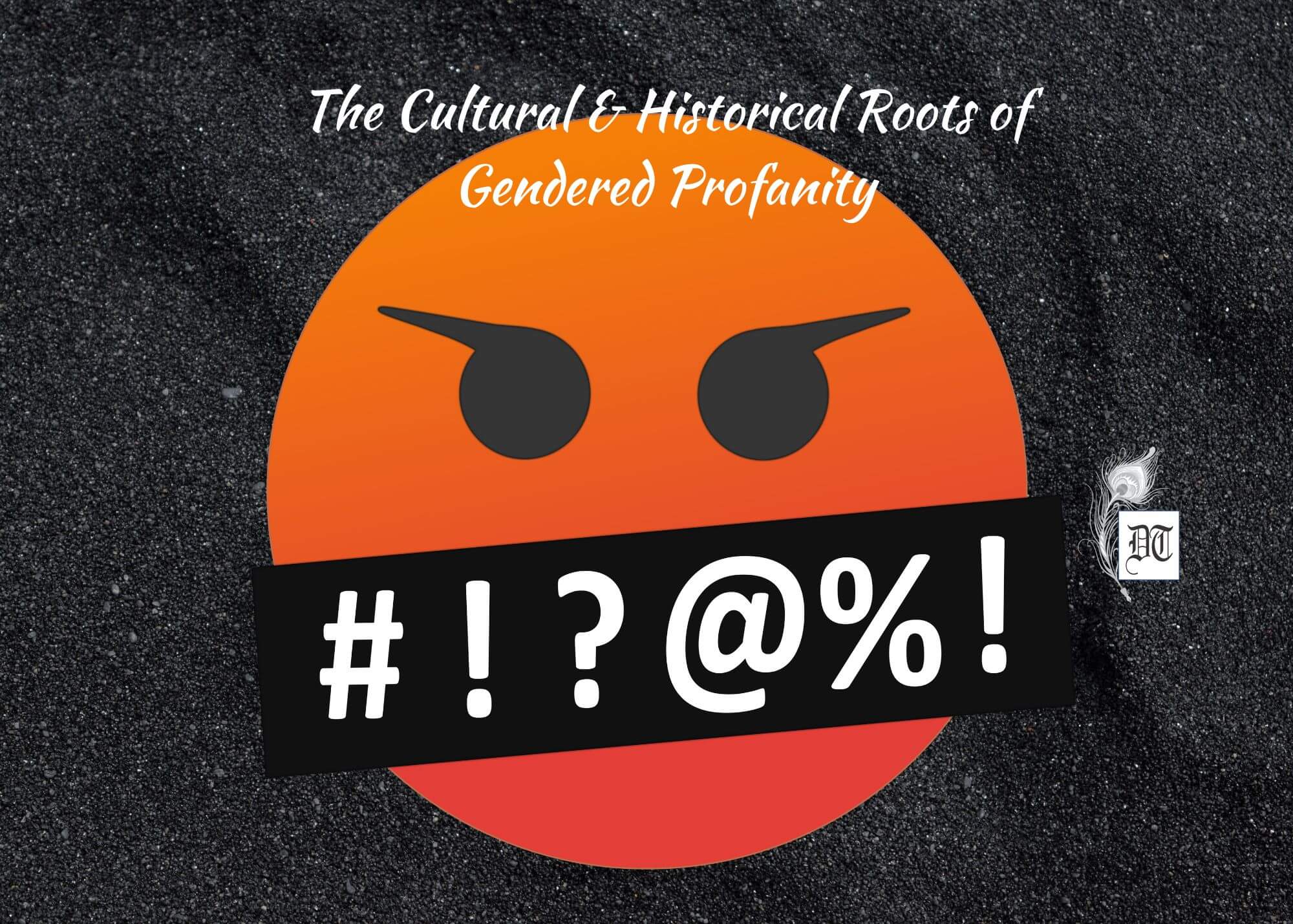Dr. Shaivya explores the relationship between language, gender, and profanity, highlighting its role in challenging traditional gender roles, exclusively for Different Truths.
Language is a mirror that reflects societal norms and shapes cultural dynamics. The article delves into the complex interplay between language, gender, and the use of profanity. A subject that is often considered provocative and taboo, especially for women. Swearing, frequently overlooked just as a linguistic taboo, is a complex phenomenon shaped by societal norms, cultural subtleties, and personal choice.
Swearing… is not immune to the subtle yet pervasive influence of gender norms.
In recent years, the discourse on gender equality and dismantling gender norms has intensified. However, the domain of profanity, a less-explored field, continues to question the intersection of gender dynamics and the usage of swear words. This article probes into the linguistic trends, societal perceptions and cultural factors that mould the swearing habits of an individual, examining if there is a sense of balance in the use of profanity by different genders. Swearing, laden with cultural and societal implications, is not immune to the subtle yet pervasive influence of gender norms. Investigating the patterns of swearing among individuals of various genders, not only promises to uncover the linguistic intricacies but also to dissect the power dynamics, social expectations, and the evolving landscape of linguistic empowerment.
Theoretical underpinnings
The study utilises established theories from sociolinguistics, feminist linguistics, and cultural studies to build a comprehensive theoretical framework that sheds light on the gender aspect of profanity. Many scholars have set the groundwork for understanding language as a dynamic and socially embedded tool.
William Labov and Erving Goffman emphasise the intricate relationship between language and society. Labov’s work on sociolinguistics variation suggests that language is intrinsically changeable and mirrors social factors such as age, ethnicity, and social class. Goffman’s concept of “face” and “face-threatening acts” helps us understand the social implications of language use. In the context of searing, sociolinguistics offers a perspective to scrutinise swearing as a socially contextualized linguistic phenomenon.
Feminist linguists like Deborah Tannen, Robin Lakoff, and Penelope Eckert have highlighted how language reflects and perpetuates gender inequality. Lakoff’s work on “Language and Woman’s Place” and Tannen’s research on gender communication style, significantly contribute to how gender can reinforce and challenge traditional gender roles. Feminist linguistic theories facilitate an examination of how the use of swear words may be gendered and are the result of power dynamics embedded in such linguistic choices.
Cultural studies, shaped by the ideas of Stuart Hill and Raymond William offer a wider perspective on understanding the relationship between language and culture. Hall’s encoding and decoding model emphasises that meaning is interpreted as per the cultural context. On the other hand, William’s concept of “Structures of feelings underscores the dynamic and evolving nature of culture. In the context of swearing and profanity cultural studies help to understand the use of swear words in the context of wider cultural norms and power dynamics.
Language is not an impartial entity, it reflects power relations, societal frameworks, and personal autonomy.
Language is not an impartial entity, it reflects power relations, societal frameworks, and personal autonomy. The article highlights the inherent prejudices and factors that shape the way we use language. The choice of words when we use the language, including swear words, is not random; it carries the weight of socio-cultural implications. The use of swear words isn’t merely about expressing strong emotions, but also about challenging authority, asserting individuality, or even reinforcing certain societal norms. It is not just about what we say, but who says it, why we say it, and the impact it has on others.
Contextualising profanity within gendered linguistic practices
Language is a system that not only serves as a means of communication but also mirrors and shapes our social realities and cultural expectations. Profanity, a linguistic taboo provides an intriguing perspective to explore the intersection of language, gender, and a societal framework.
Societal expectations have a significant influence on the linguistic behaviour of an individual, especially when it comes to profanity. From time in history, women are mostly associated with politeness and nurturing language and may encounter different societal expectations than men when it comes to profanity.
A woman using profanity may be perceived as transgressive against the societal norms of feminine language. As women are often dictated by societal expectations, they are expected to adhere to the norms of politeness and avoid explicit and strong language. When a woman chooses to use such language, she challenges the traditional gender roles associated with linguistic decorum. For example, a female character in a movie breaks all the gender norms with her deliberate use of strong language, she challenges stereotypes, asserts her individuality, and disrupts the status quo. In that process, she becomes a symbol of authenticity and defiance.
The power dynamics are intricately embedded in language use, either by men or women. Profanity is not just about the words; it extends beyond word choices. In the context of gender, the power imbalance dictates the social license to use certain words and expressions. This dynamic is often intertwined with historical patriarchal structures and traditional gender roles. For instance, Historically, men may have more social permission to use profanity without facing any severe repercussions. It underscores the power imbalance in the language that existed from the time in history.
Profanity becomes a tool for subversion and empowerment when wielded consciously.
Profanity becomes a tool for subversion and empowerment when wielded consciously. Individuals, especially the marginalised gender, use profanity as a linguistic agency to challenge societal norms and assert their autonomy. For instance, A woman using profanity as an act of resistance to subvert social norms becomes a way to push back against oppressive structures and assert her voice. It becomes a way to self-express, and defiance, which empowers the women to reclaim the linguistic space that has been historically used against them. The voices of women have been stifled to specific roles from the time in history. Many times, profanity becomes a way to break free from this silence, allowing them to express themselves the way they wish.
For instance, when a female comedian uses profanity, it defies the notion that women should adhere to certain linguistic decorum. Instead, it asserts that women can be unapologetically raw, real, and bold. Profanity acts as a tool of authority for women, and by using strong language they claim their linguistic space, demand attention, and assert their right to be heard. She connects with the audience on her terms. A woman’s use of profanity acknowledges the fact that language is not always prim and proper – it’s messy, real, and emotional. Profanity becomes a bridge – a way to cross over from silence to self-expression.
In a culture where traditional gender roles are rigid, the use of profanity by the individual especially women, might be viewed as breaking away from the cultural norms challenging the notion of femineity. As it often prescribes specific linguistic behaviours based on gender.
Profanity has its roots deep in cultural and historical contexts. The acceptability and the appropriateness of certain words can vary significantly across cultures. Every culture has its own set of linguistic norms, which are often shaped by historical events, collective experiences, religious beliefs, and social values. Profanity has evolved, words that were once considered vulgar might lose their potency with the emerging new ones.
Profanity fosters solidarity among women as the shared language that is raw and unfiltered helps create a bond…
Profanity fosters solidarity among women as the shared language that is raw and unfiltered helps create a bond and empowers collective voices. With the help of such collective voices, they challenge the oppressive norms. It is used as a form of resistance against sexist remarks and to reclaim the social and linguistic space traditionally dominated by the male. For example, in a heated Twitter thread, a woman, responds to sexist comments, when she is tired of enduring it with a well-placed expletive. She asserts her presence, pushes back against misogyny, and disrupts the status quo. The digital spaces amplify the female voices. Profanity flows more casually on social media. It is a part of everyday discourse, not just a value shock.
Digital spaces directly align with the linguistic space of women. It provides them with unique arenas, and within these digital spaces, profanity becomes a multifaced tool for women. It helps them express their emotions and frustration; it’s a way for them to cut through the noise and be heard. The portrayal of women using profanity in social media and popular culture can either influence the perception of acceptability or challenge the prevailing gendered linguistic norms and inadvertently reinforce them.
Women today, especially young women are navigating through a different landscape. They are growing up in an era where self-expression is valued. As the societal attitude evolves, the younger generation embraces profanity more casually. This shift is a sign of departure from old and traditional norms. This generational shift redefines how profanity is wielded and is on its way to creating a new linguistic space and practices for women. The use of profanity by women once frowned upon or restricted may gradually become more normalised. Such a shift reflects the changing linguistic norms and highlights the dynamics of language, gender, and society.
Factors influencing the use of profanity in women
The use of profanity in the context of gendered language norms is due to many factors that are associated with the choice and use of profanity by an individual. Language is not arbitrary; it is a tool shaped by various influences.
Profanity, a part of the linguistic repertoire of an individual, carries weight beyond words. An individual’s choice of language reflects cultural norms, personal identity, and social and religious context. It is often laden with connotations and emotions. Profanity doesn’t exist in isolation. It is deeply woven into power structures and societal norms and expectations. For a time in history, certain words have been deemed more appropriate and acceptable in the language use of men as compared to women. When women reclaim the profane language, they challenge such imbalance, as women have always been discouraged from using strong language. When women use profanity, they defy the stereotypes associated with the female gender.
The use of profanity by women is beyond the word usage. It is about equality…
The use of profanity by women is beyond the word usage. It is about equality, it is about challenging the historical silence, and it is a tool of empowerment – a way to amplify their voice. The study of profanity with the help of a gendered lens, gives insight into the societal attitudes and cultural evolution of women. It is woven into the fabric of identity, empowerment, and change. Each instance discussed in this article emphasizes how female individuals navigate, challenge, and shape gendered linguistic practices through the intentional use of profanity in various contexts. These instances illustrate the diverse ways in which women engage with language, asserting agency, challenging norms, and contributing to the ongoing evolution of gendered linguistic practices.
Conclusion
This article is more than an academic investigation; it serves as a trigger for societal self-examination. As the article navigates through the intricate relationship between language, gender, and profanity, it transcends the confines of the collection of findings. It seeks to spark conversations; conversations about the power dynamics inherent in our daily language usage, conversations that resonate in corporate boardrooms, homes, and digital spaces.
As we find ourselves on the threshold of linguistic understanding, we realise that profanity extends beyond word selection for women. It is not just about the words they choose; it reflects who they are, how they navigate through power hierarchies, and how they collectively contribute to the evolving dynamics in the linguistic environment. “Profanity in Parity” challenges to reevaluate the impact of their words laying the ground for a more inclusive, empowered, and nuanced linguistic future.
References
1. Eckert, P. (1989). Variation and the Indexical Field. Journal of Sociolinguistics, 13(2), 163-195.
2. Goffman, E. (1967). Interaction Ritual: Essays on Face-to-Face Behavior. Anchor Books.
3. Hall, S. (1980). Encoding/Decoding. In S. Hall, D. Hobson, A. Lowe, & P. Willis (Eds.), Culture, Media, Language (pp. 128-138). Hutchinson.
4. Labov, W. (1966). The Social Stratification of English in New York City. Cambridge University Press.
5. Lakoff, R. (1975). Language and Woman’s Place. Harper & Row.
6. Tannen, D. (1990). You Just Don’t Understand: Women and Men in Conversation. HarperCollins.
7. Williams, R. (1983). Culture and Society, 1780-1950. Columbia University Press.
Picture design by Anumita Roy





 By
By
 By
By
 By
By
 By
By